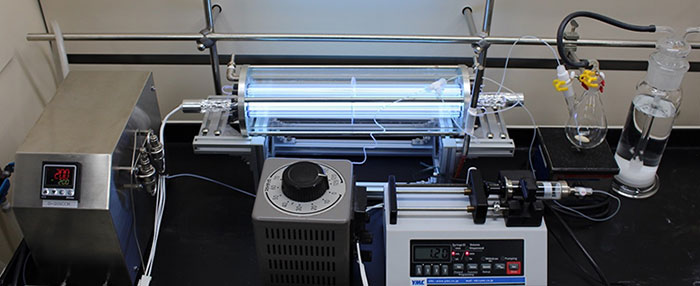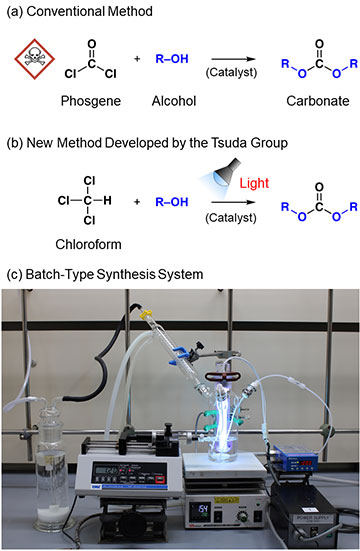Various chemical products, such as polymers and pharmaceutical intermediates, are currently synthesized with phosgene as their precursor or raw material. However, phosgene is highly toxic and this usage poses safety risks. Thus, there is demand for the development of new methods and substitutes to replace phosgene. In collaboration with industry, Associate Professor TSUDA Akihiko's research group at Kobe University Graduate School of Science has become the first in the world to successfully develop a new flow photo-on-demand synthesis system that uses chloroform as the precursor. Using this system, they were able to synthesize phosgene-derived chemical products. Furthermore they achieved a high conversion rate (over 96%), synthesizing these useful compounds in a short period of time (a minute or less of light exposure). The system has multiple advantages; it is safe, inexpensive and simple with a low impact on the environment. It can be used to synthesize various chemical products, which it can produce continuously in large quantities. The researchers expect that this system can be scaled up into a model system of industrial production in the near future.
Patents for this system were filed in Japan in February 2021 and internationally in January 2022. Following the patent announcement in August 2022, the related academic paper was published online in Organic Process Research & Development (OPR&D) on November 11, 2022.

Main Points
- From the common organic solvent chloroform and commercially available alcohol, the researchers successfully synthesized pharmaceutical intermediates and polymers at a highly efficient rate (over 96%) and in a short amount of time (a minute or less of light exposure).
- They showed that continuous production is possible, which cannot be done with conventional batch systems.
- In 2 hours, they successfully synthesized up to ten grams of chemical products (and this can be scaled up)
- They synthesized 10 types of functional carbonates and 3 types of polycarbonates as examples.
- Improved safety compared to the standard method of producing phosgene (a strong exothermic reaction of carbon monoxide and chlorine gas that uses a carbon catalyst). The chloroform used as a precursor in the new method is easy to store safely and the chemical reaction can be controlled by exposure to light.
- The byproduct of this new method is mostly hydrogen chloride (neutralized by alkali), therefore dirt does not build up inside the system apparatus. The reduced need to clean the inside lessens the environmental impact and lowers costs.
- The system achieves continuous production without the additional use of organic solvents.
- This new chemical reaction system is expected to make a significant contribution in the move towards carbon neutral and sustainable societies.
Research Background

Figure 2. Methods for synthesizing carbonate esters.
(a) A conventional reaction with phosgene, (b) the photo-on-demand phosgenation reaction developed at Kobe Univ., and (c) a batch-type reaction system for the photo-on-demand chemical synthesis developed at Kobe Univ.
Phosgene (COCl2) is used as precursor for polymers and as a pharmaceutical intermediate. The global phosgene market continues to grow by several percent each year, with around 8 to 9 million tonnes produced annually. However, phosgene is extremely toxic. For safety reasons, research and development is being conducted to find alternatives. In a world-first discovery, Associate Professor Tsuda's research group irradiated chloroform with ultraviolet light, which caused it to react with oxygen and generate high yields of phosgene (patent no. 5900920). In order to do this in an even safer and easier manner, the research group found a way that the phosgene-generating reactions could be instantly performed. They first dissolved the reactants and catalysts in chloroform, and generated phosgene by irradiating the solution with light (patent no. 6057449). In this way, phosgene-based organic synthesis can be carried out as if phosgene wasn't used.
The research group has named their discovery 'photo on demand organic synthesis method' and have successfully used it to synthesize numerous useful organic chemicals and polymers (list of patents (in Japanese): Patents of Tsuda Laboratory






